Shifting Skills, Moving Targets, and Remaking the Workforce
By Matt Sigelman, Bledi Taska, Layla O’Kane, Julia Nitschke, Rainer Strack, Jens Baier, Frank Breitling, and Ádám Kotsis
MAY 23, 2022
This is a republication of an excerpt of the article “Shifting Skills, Moving Targets, and Remaking the Workforce”, with the title above, focusing on the topic in question.
What’s Driving Skill Disruption?
- We attribute this skills change to the pandemic, which forced businesses to rethink operations and people in all kinds of occupations to embrace new ways of working and new skills.
- But the main driver of change in requested skills is technology. Technology is reshaping many, if not most, jobs.
What are the 4 big trends in skills change?
- Digital skills, like technical fluency and abilities including data analysis, digital marketing, and networking, aren’t limited to jobs in IT.
- Soft skills, like verbal communication, listening, and relationship building, are needed in digital occupations.
- Visual communication has become increasingly important even outside of traditional data occupations. Experience with tools such as Tableau, MS Power BI, and Adobe Analytics is in high demand.
- Social media skills, such as experience with Facebook, LinkedIn, and Adobe Photoshop, are in demand in the current media climate.
When we look at the most disrupted IT jobs, we see particular trends in the pattern of change:
- Designing in a Modular Fashion.
Client-server-based approaches are being replaced by modular, app-based, and service-focused solutions that can interface with third-party systems.
With this move comes the need for expertise in new software programs and languages, including Vue.js and Kubernetes.
- Relying on the Cloud.
Data centers once hosted on site are migrating to the cloud, requiring orchestration of private, public, and on-premise IT systems.
This again brings a need for skills with new programs and languages, among them TensorFlow and Azure.
- Emphasizing Data and Advanced Analytics.
Inconsistent silos of structured databases have become harmonized collections of unstructured data, enabling process automation and personalized customer journeys, among other things.
Expertise in concepts like artificial intelligence and deep learning are becoming key skills here.
- Using Multiple Channels.
Monolithic, siloed systems are giving way to loosely coupled components reused across multiple channels.
Making that happen requires IT professionals with skills in server configuration as well as a variety of programs and languages, like Typescript and AWS Redshift.
- Working in Agile Ways.
Moving from a single-speed, waterfall-style delivery process to a multispeed, scaled project management approach puts an emphasis on skills like agile ways of working and workflow management.
What are the implications for stakeholders?
- Over just five years, skill change has been rapid and wide ranging. In some occupations, it has been overwhelming.
- The consequent impact on organization leaders, HR teams, educators, public-sector agents, and individuals is profound.
- There’s a need to seek talent with new skills, to reskill and upskill employees, and to train and develop those in search of jobs.
- And all of this must happen while the skill profiles of many jobs continue to morph-it’s a moving target.
- The good news is that with the help of big data and analytics -tools that underpin this very report-we can understand the nature and details of the changes.
ORIGINAL PUBLICATION (excerpt)

Shifting Skills, Moving Targets, and Remaking the Workforce
By Matt Sigelman, Bledi Taska, Layla O’Kane, Julia Nitschke, Rainer Strack, Jens Baier, Frank Breitling, and Ádám Kotsis
MAY 23, 2022
Discussions about the job market usually focus on jobs created and destroyed. But even in the most tumultuous times, that is not what most workers or most businesses experience.
Jobs do come and go, but even more significantly, jobs change.
Day by day, skill by skill, the basic building blocks of a job are repositioned, until the role looks much different than it did just five years ago.
Yet the job title-and the worker in the job-may remain the same.
But even company leaders may not realize how profoundly and rapidly the jobs throughout their business and industry are evolving.
A comprehensive look at job listings from 2016 through 2021 reveals significant changes in requested skills, with new skills appearing, some existing skills disappearing, and other existing skills shifting in importance.
The challenge for employers and employees alike is to keep up-or, better yet, to get ahead of the trends.
The challenge for employers and employees alike is to keep up-or, better yet, to get ahead of the trends.
The Skill Disruption Index
To meet the challenge , we analyzed millions of online job advertisements posted between 2016 and 2021 and created the Skill Disruption Index, which yielded a comprehensive list of occupations, each assigned a relative value from 100 for the job with the greatest disruption (data engineer) to 0 for the job with the least disruption (mystery shopper).
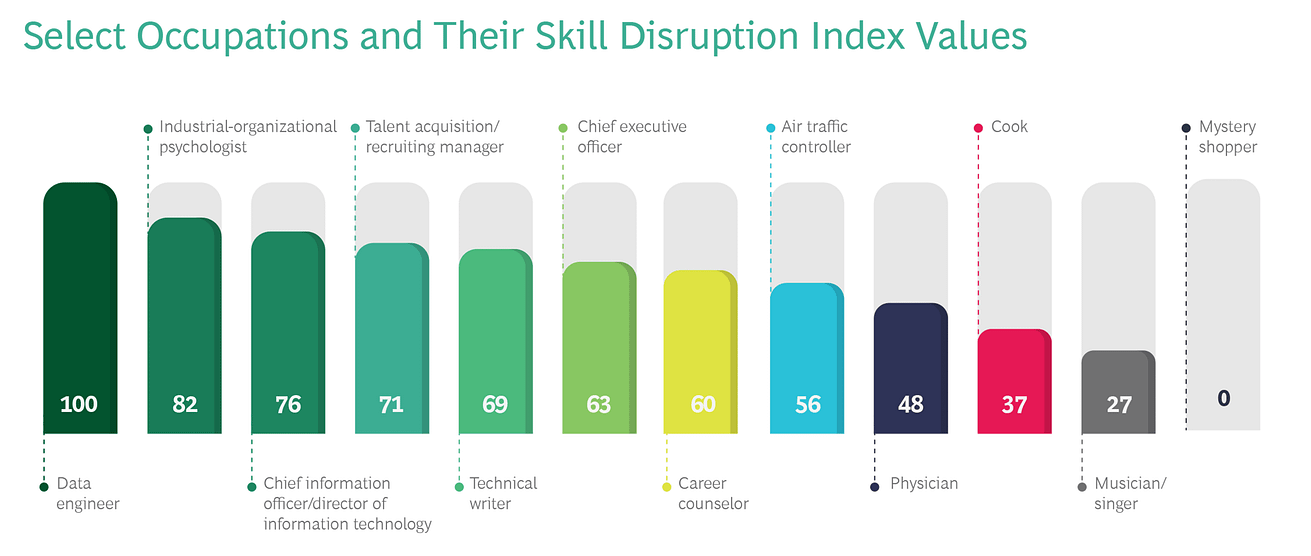
We looked at the skills that employers requested in job postings each year and compared those skills with the ones requested for the same occupation in 2016. We broke down the change in two ways.
First, we looked at the skills that were completely new to jobs-the ones that employers didn’t ask for at all in 2016.
Then, we looked at whether skills became more or less important to a role. Were they requested more or less frequently as time went on?
The first way of breaking down skills is like seeing the initial blip on a radar screen; the second is more akin to using the Doppler effect to see if the target is speeding up or slowing down.
The Skill Disruption Index, which combines the two measures mentioned above (the emergence of new skills and the change in the importance of skills), allows us to compare how rapid and significant the changes are in specific roles. (The full report includes an appendix showing how all occupations in the database rank in the Index.)
In fact, the pace of change has accelerated such that jobs are more disrupted today than ever before: we consider this period of time to be the Great Disruption, a workforce phenomenon that demands swift and thoughtful action by employers and other stakeholders.
Leaders and decision makers need to understand what skills their organization needs and how to access them. Essentially, they need to capture a moving target.
…the pace of change has accelerated such that jobs are more disrupted today than ever before:
we consider this period of time to be the Great Disruption, a workforce phenomenon that demands swift and thoughtful action by employers and other stakeholders.
Leaders and decision makers need to understand what skills their organization needs and how to access them. Essentially, they need to capture a moving target.

What’s Driving Skill Disruption?
In reviewing the five-year data, we detected an acceleration in the pace of change. Nearly three-quarters of jobs changed more from 2019 through 2021 (a CAGR of 22%) than they did from 2016 through 2018 (19%).
We attribute this increase to the pandemic, which forced businesses to rethink operations and people in all kinds of occupations to embrace new ways of working and new skills.
We attribute this increase to the pandemic, which forced businesses to rethink operations and people in all kinds of occupations to embrace new ways of working and new skills.
But the main driver of change in requested skills is technology.
Technology is reshaping many, if not most, jobs.
Sometimes this is dramatic, as in the explosion of phone apps in e-commerce. Sometimes, it is subtle: the replacement of the clipboard by the tablet in fields from trucking to health care or the price gun by the barcode in the supermarket.
But the main driver of change in requested skills is technology.
The impact of technology change extends far beyond fields that are intrinsically technical, like IT, engineering, and science and research.
The proliferation of technologies that can be put to effective use in these roles is changing the understanding of “tech job.”
A marketing specialist, a client support employee, a writer, an HR manager-and many more-must now have technical proficiencies as well as their traditional expertise.
See the slideshow below.
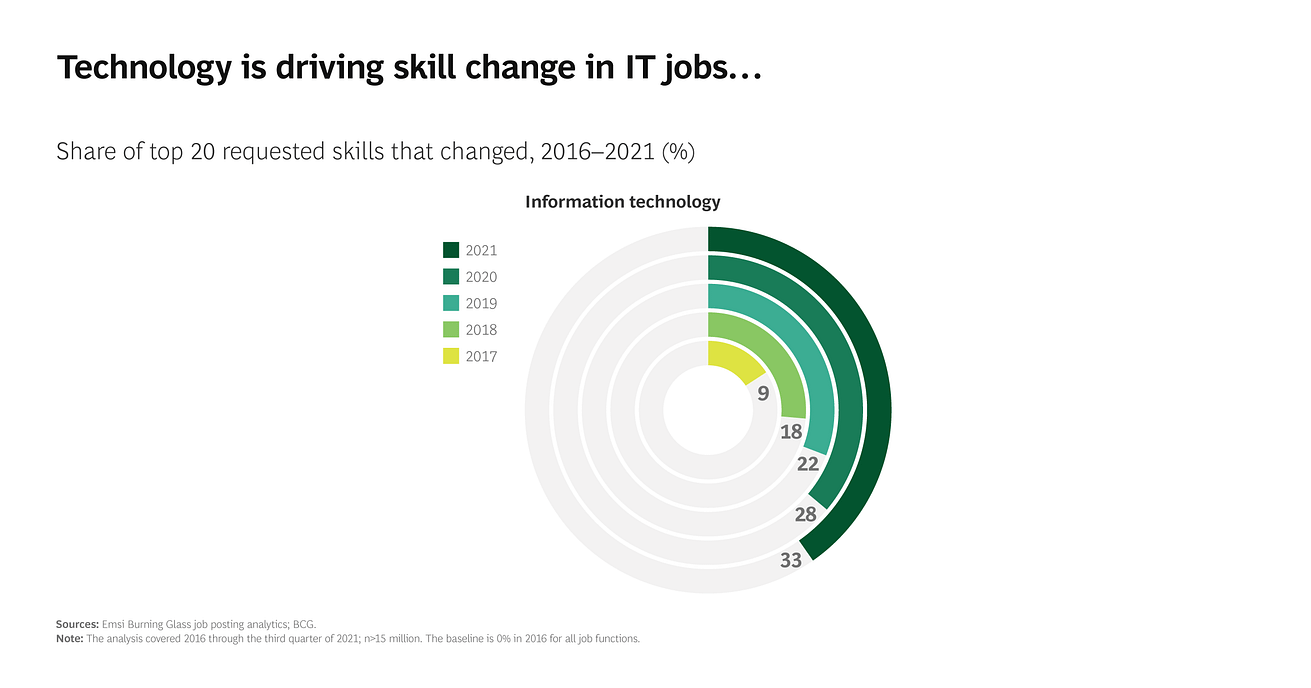
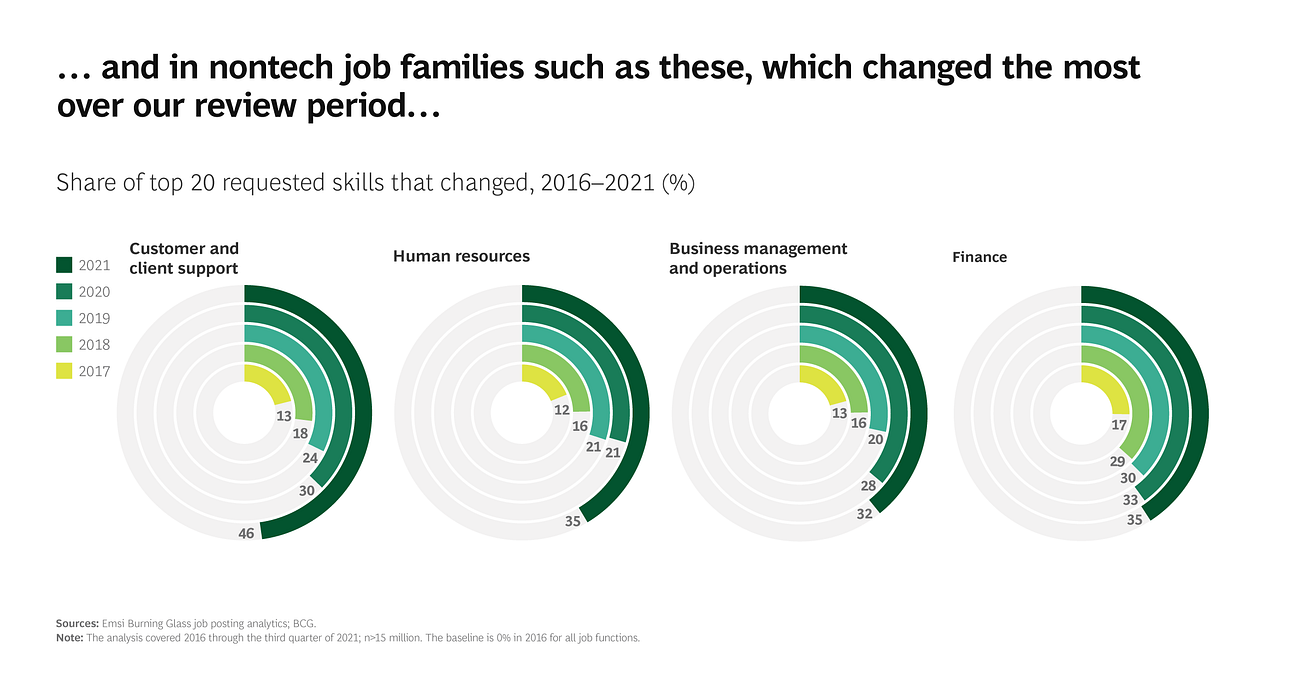
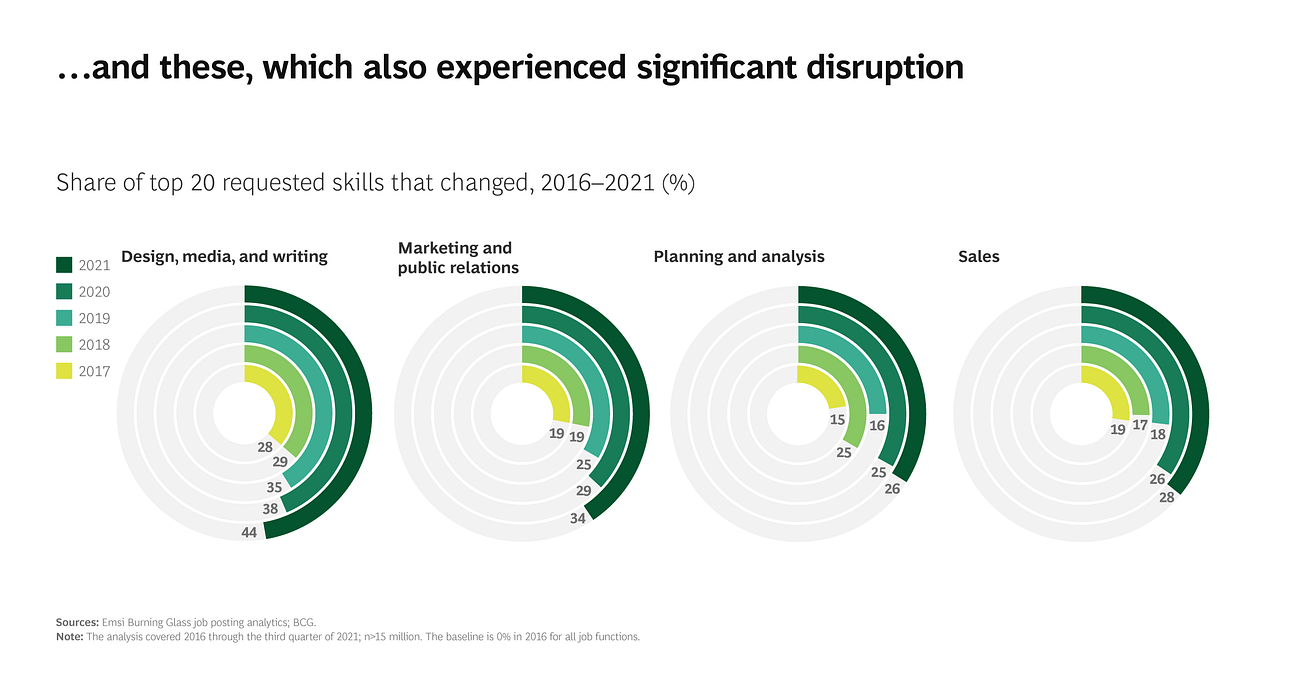
The impact of technology change extends far beyond fields that are intrinsically technical, like IT, engineering, and science and research.
What Skill Disruption Looks Like
A closer look at skill disruption in one job family-marketing and public relations-shows the impact of skill disruption. The marketing and PR job family is a useful example: companies across industries include this department, so it’s widely relevant.
Drilling down further into one specific occupation-marketing specialist-is a good proxy for skill disruption in this job family overall as well as the way technology is driving skill change. “Marketing specialist” is a common role (15% of postings for marketing jobs are for marketing specialists) that exists in multiple companies and industries, and requested skills changed significantly over the past five years. Thus, a deeper look at the skills requested of a marketing specialist approximates the skill changes across the entirety of the job family. See the slideshow below.
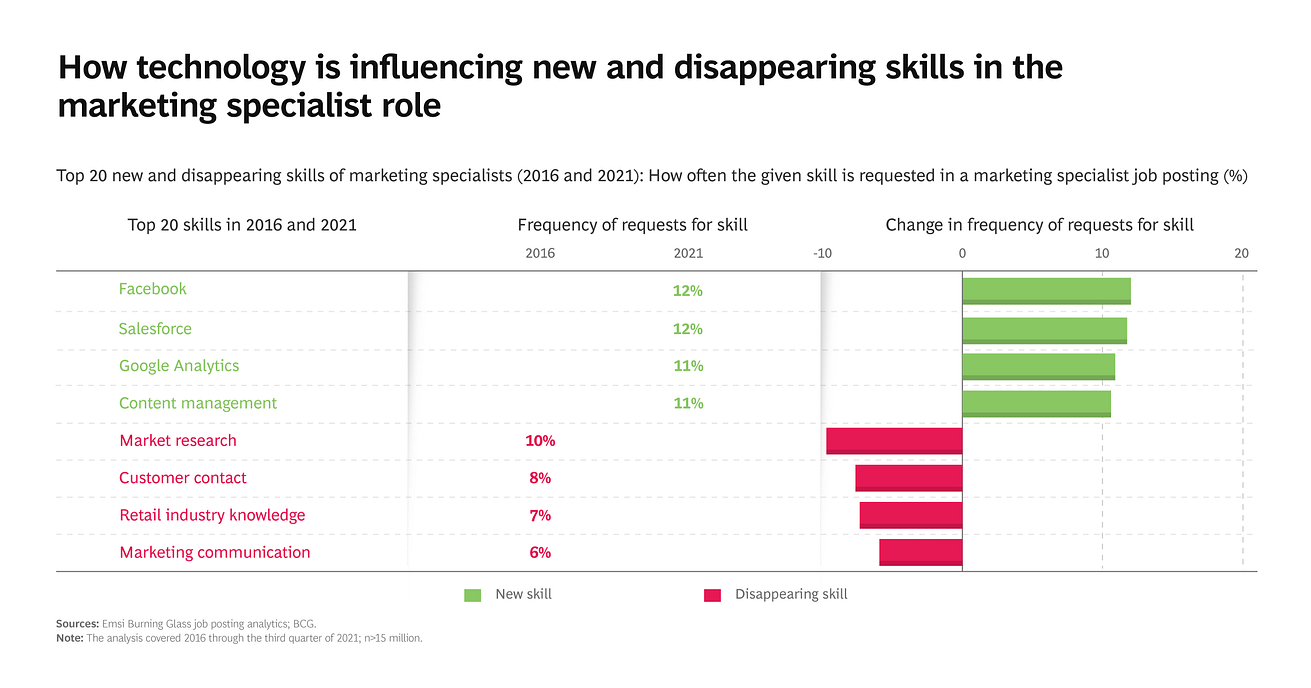
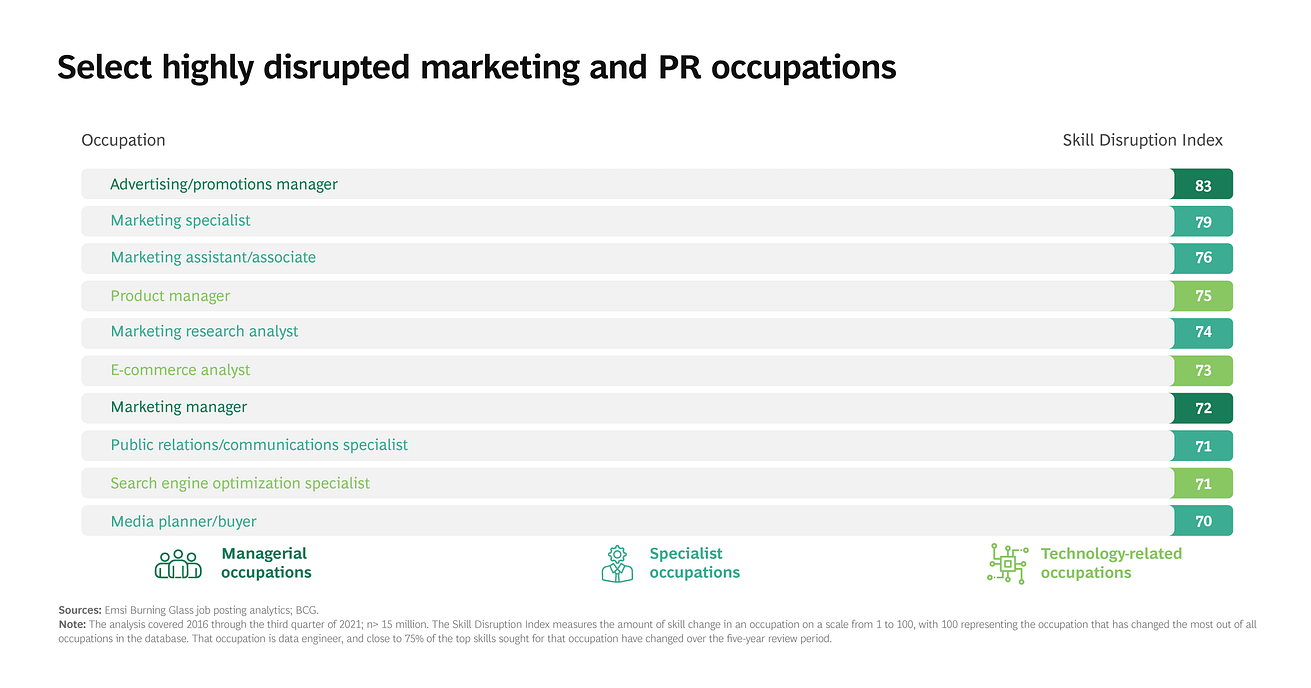
Four Big Trends
We see four big trends in skill change:
- Digital skills, like technical fluency and abilities including data analysis, digital marketing, and networking, aren’t limited to jobs in IT.
- Soft skills, like verbal communication, listening, and relationship building, are needed in digital occupations.
- Visual communication has become increasingly important even outside of traditional data occupations. Experience with tools such as Tableau, MS Power BI, and Adobe Analytics is in high demand.
- Social media skills, such as experience with Facebook, LinkedIn, and Adobe Photoshop, are in demand in the current media climate.
Disruptive Skills Across the Labor Market
From AI to supply chain disruption, from connectivity to climate change, the global trends shaping business decisions are becoming ever more complex.
Over the past two years, the pandemic has accelerated these changes. Companies must adjust what they do and how they do it.
New initiatives, new technologies, and new strategies are all required, but if the company’s workforce doesn’t have the right skills, it is extremely hard to succeed.
If a company launches new digital tools, for instance, but its employees are not able to use them, the new tools will hardly live up to their desired impact.
Investments in recruitment, upskilling, and reskilling must accompany technology investments.
Even when it’s clear that new approaches are required — and even when they are underway — it’s hard to gauge the true degree and pace of change across job roles, within a company and across an industry or job family.
For employers, it’s critical to understand shifting requirements for the roles important to their business.
With that insight, they can adapt their recruitment and development practices and thereby keep their workforce and their organization competitive.
To provide data and insights with broad value, we’ve focused on four job families that are also core functional areas common across businesses and industries.
These are also job families with relatively high average Skill Disruption Index values.
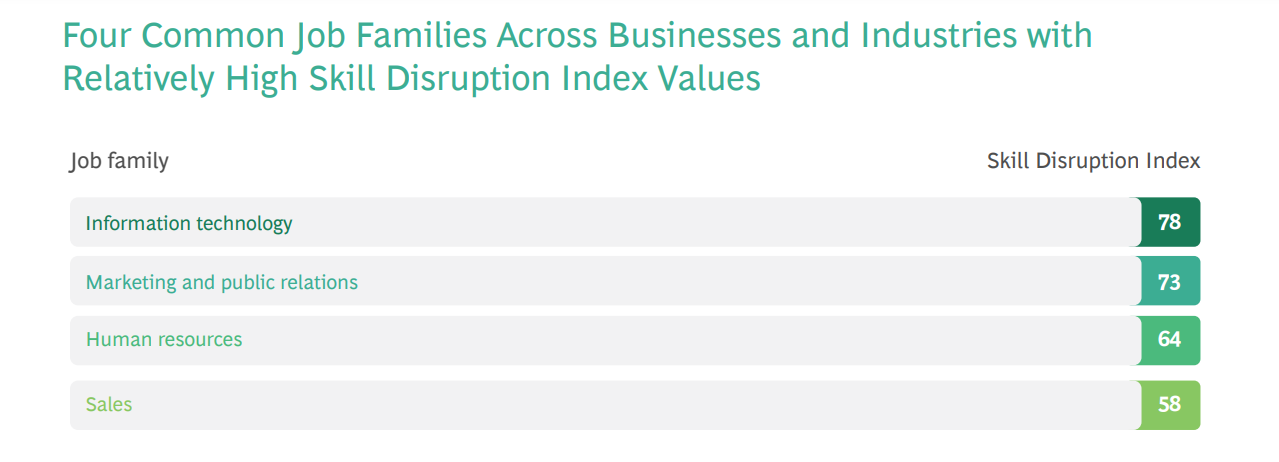
Within each job family, we examined the specific jobs with the highest Skill Disruption Index numbers (meaning that they are highly disrupted jobs) and then took a deeper look into the top disrupted job to see how skills changed from 2016 through 2021; looking at the top job gives a sense of changes across the family.
This analysis helps us to understand the depth of the skill disruption in these key functions and the function-specific drivers involved in the disruption.

1.Information Technology
Given the significance of technology as a driver of change, it comes as no surprise that skill disruption is higher in IT than in any other job family. (This finding is based on examination of all jobs and skills within IT, not just on a look at the top 20 skills across job families, as shown earlier.)
Data, the web, software, online experiences, and more are changing occupations across the board; these skills are ensconced in IT, of course, so here we see great skill disruption across front-end, systems, and data occupations. (See Exhibit 4.)
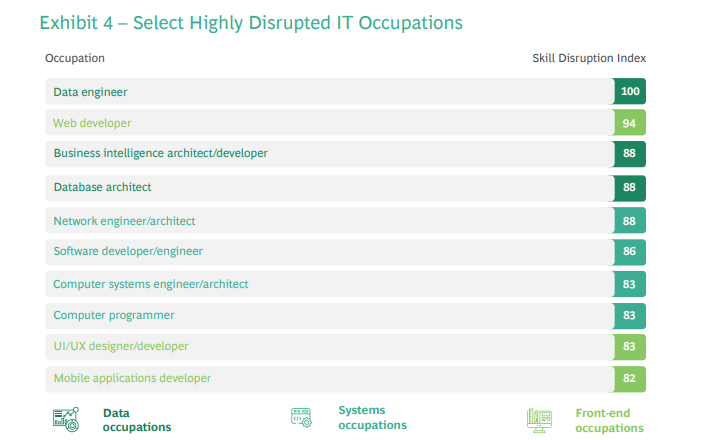
The most disrupted occupation in IT is also the occupation at the top of our Skill Disruption Index: data engineer. New skills requested in this role since 2016 are Microsoft Power BI and artificial intelligence. Most skills that increased in importance for this role are technical in nature; skills that declined in importance were also specific technology capabilities, such as Ruby and the PERL scripting language.
When we look at the most disrupted IT jobs, we see particular trends in the pattern of change:
- Designing in a Modular Fashion.
Client-server-based approaches are being replaced by modular, app-based, and service-focused solutions that can interface with third-party systems.
With this move comes the need for expertise in new software programs and languages, including Vue.js and Kubernetes. - Relying on the Cloud.
Data centers once hosted on site are migrating to the cloud, requiring orchestration of private, public, and on-premise IT systems.
This again brings a need for skills with new programs and languages, among them TensorFlow and Azure. - Emphasizing Data and Advanced Analytics.
Inconsistent silos of structured databases have become harmonized collections of unstructured data, enabling process automation and personalized customer journeys, among other things.
Expertise in concepts like artificial intelligence and deep learning are becoming key skills here. - Using Multiple Channels.
Monolithic, siloed systems are giving way to loosely coupled components reused across multiple channels.
Making that happen requires IT professionals with skills in server configuration as well as a variety of programs and languages, like Typescript and AWS Redshift. - Working in Agile Ways.
Moving from a single-speed, waterfall-style delivery process to a multispeed, scaled project management approach puts an emphasis on skills like agile ways of working and workflow management.
Exhibit 5 shows how these trends in IT are changing requested skills across IT occupations.
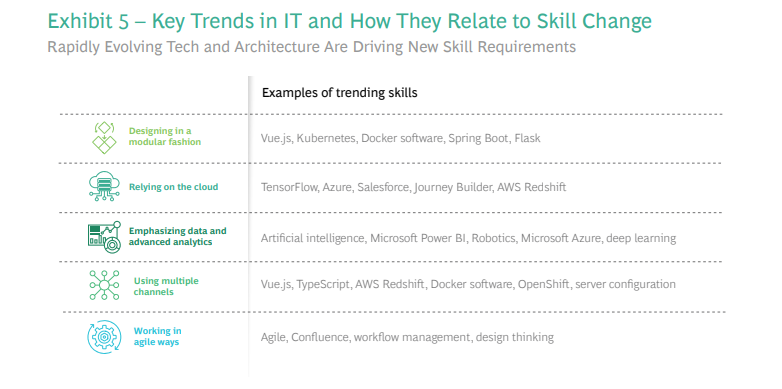
2. Marketing and Public Relations
3.HR
4.Sales
For details about the other job families (2 to 4 listed above), please, refer to the long version of the publication.

Implications for Stakeholders
Over just five years, skill change has been rapid and wide ranging. In some occupations, it has been overwhelming.
The consequent impact on organization leaders, HR teams, educators, public-sector agents, and individuals is profound.
There’s a need to seek talent with new skills, to reskill and upskill employees, and to train and develop those in search of jobs.
And all of this must happen while the skill profiles of many jobs continue to morph-it’s a moving target.
The good news is that with the help of big data and analytics -tools that underpin this very report-we can understand the nature and details of the changes.
There’s a need to seek talent with new skills, to reskill and upskill employees, and to train and develop those in search of jobs.
Implications (in general)
Over just five years, skill change has been rapid and wide ranging. In some occupations, it has been overwhelming.
The consequent impact on companies, individuals, and societies is profound.
There’s a need to seek talent with new skills, to reskill and upskill employees, and to train and develop those in search of jobs.
And all of this must happen while the skill profiles of many jobs continue to morph — it’s a moving target.
The good news is that with the help of big data and analytics — tools that underpin this very report — we can understand the nature and details of the changes.
Job families and specific jobs can be examined in detail, as we have shown with our examples, to understand which new skills are emerging, which are becoming more important, and which are losing relevance over time.
Managing such changes is complex. It requires:
- strong C-suite and HR leadership capabilities,
- clarity on the strategic direction of the enterprise,
- understanding of the dynamics of each industry sector and the talent within those sectors,
- foresight regarding new trends, talent planning on multiple time horizons, and
- strong capabilities in leaders and HR functions.
It also requires a fair amount of agility to react to ongoing change and unanticipated disruptions in trends.
Organization leaders, HR teams, educators, public-sector agents, and individuals must contribute time and effort to address skill challenges and opportunities:
1.Organization Leaders.
Many organization leaders across industries are working to define the future of their core business and support functions — from technological change to new ways of working.
These organizations need to clarify their strategic direction and then assess how roles need to evolve, in skills and capacity and at what speed, to support that strategic direction.
Frequently, organization leaders will need to shake their teams out of status quo thinking and timid incrementalism to prepare for the substantial shifts that are going on across sectors and roles and to get ahead of the curve instead of falling behind.
2.HR Teams.
HR teams must partner with organization leaders to define the talent-sourcing strategies (from among the buy-build-borrow-automate options) that will supply needed skills at the capacity and pace required by the organization’s strategic objectives.
Learning and development functions will play a critical role, equipping workers at all levels and at scale with the rapidly advancing skills required to succeed, but those internal efforts likely won’t be enough to satisfy all talent and skill needs.
L&D, recruiting, talent management, and people analytics functions will have to work together via holistic, integrated approaches.
Strong HR business partners (HRBPs) must serve as powerful connection points between the business and the HR capabilities, to support customization, agile experimentation, and fit-for-purpose solutions
3.Educators and Public-Sector Leaders.
Educators, training providers, and governments need to prepare for their role in this challenge.
Not only does the lifelong learning challenge change the focus in education, but the pace of skill change also requires educators to rethink both the curriculum and the process by which they review and adapt curriculum, to make learning more agile and responsive to changing circumstances and available to learners in productive, easily accessed formats.
They must also guide individuals to the right kind of learning. Workers also need actionable information about how their jobs are changing.
Failing to acquire new skills is bad, but so is acquiring the wrong skills — those that don’t provide a return on investment in pay or advancement.
Both employers and educators should provide clear guidance on how skills link to career pathways.
4.Individuals.
The job you’ve been showing up to faithfully for years is, most likely, no longer the one you signed up for — and that’s okay in the context of career longevity.
Workers and job seekers need to embrace lifelong learning.
People should look for employers and programs that help to build the skills needed to stay relevant.
Skill change is a constant evolution — and a source of ongoing disruption across the economy.
The pandemic has accelerated the process, but facing the fact that jobs are always evolving, even when not in the midst of a crisis, is a major shift in how the world thinks about the nature of work.
Staying informed and rethinking processes to get ahead of trends will be the key to flourishing in an increasingly dynamic talent landscape.
The job you’ve been showing up to faithfully for years is, most likely, no longer the one you signed up for — and that’s okay in the context of career longevity.
Workers and job seekers need to embrace lifelong learning.
Originally published at https://www.bcg.com on May 18, 2022.












